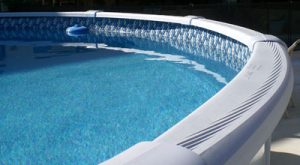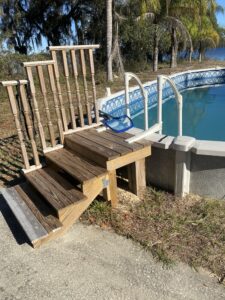It can be very hard to get an above-ground swimming pool repaired in Orlando. In truth, Orlando and the surrounding counties of Orange, Osceola, Lake, Polk, and Volusia have very few companies that work with above grounds.
Most needing above-ground pool repair will begin by calling their local retail pool supply store like Pinch-A-Penny or Leslie’s only to find that they only service inground pools.
Next, they try pool service companies close to them. With them, they get the same rejection to AG pools.
Those persistent (or desperate) enough eventually find one of the half dozen above-ground pool guys in Central Florida, like me. When they finally get ahold of someone like me, they are ready to get something done quickly.
At that point, the above-ground pool guy (me) has to break it to them that he either doesn’t do that kind of repair OR is way too busy with full pool installs.
MOST WANT TO GET THEIR POOL REPAIRED DURING THE HOT MONTHS
Even though there are thousands of above-ground pools in need of something, I, along with the maybe five other above-ground pool guys in Central Florida, sit dormant starting as early as September through February.
This is because most above-ground pool owners don’t care about fixing their pools until it gets hot outside. Then, when it hits 90 degrees outside sometime in the spring, the phone comes to life as hundreds decide that they want to do something with their pools.
To make matters much worse, this is the same time that people wanting to get a pool start looking to get one. And since I and the five other guys around Orlando make most of our living doing full installations, we get too busy to do any other type of pool job.
THE DIFFERENT TYPES OF REPAIRS PEOPLE WANT FOR ABOVE-GROUND POOLS IN ORLANDO
Thinking that you can call one person to take care of any or all your needs for your above-ground pool is common with people starting out. In reality, it’s going to be hard to find anyone to do most things with an above-ground pool.
A guy like me for example will only mainly install pools or put new liners in them. It isn’t worth it for me to do much more than that during the busy season (which is when 90 plus percent inquire about a repair.
To possibly help you find someone for your issue, here’s a list of issues that people look for someone to help them with.
1 To find a leak
This is a super common reason people need a pool guy. Almost every pool will eventually leak, and above-ground pools are no exception to this.
When I started my pool service company in the late 1980s, pool service guys did everything (including find leaks). In the early 90s, leak detection-only companies started popping up in and around Orlando.
Now, few (inground) pool service guys will look for a leak. Most now will refer you to a leak detection company.
This holds true for above-ground pools too, although AG pool owners rarely opt to pay the expensive cost of a leak detection company.
YOUR OPTIONS
A Learn how to and find the leak yourself
B Call a leak detection company
2 To repair a leak
When it comes to vinyl above-ground swimming pools, finding the leak is almost always the hard part. Patching a found leak in the vinyl somewhere is very easy.
Again though, you most likely won’t find anyone who will repair the leak. Now, if the leak is somewhere within the pool’s equipment (pump, filter, piping, etc.), then you have a slightly better chance of finding a pool guy to fix that.
More than likely though, you’ll be on your own fixing any leak in your AG pool.
YOUR OPTIONS
A Learn how to and fix the leak yourself
B If within the equipment and visible, possibly find a pool guy or store willing to do it.
C If in the liner somewhere and the liner is more than 4 years old, replace the entire liner
3 Pump not working
There is a big difference between inground pool pumps and above-ground pool pumps. This is why pool stores will repair inground pool pumps and/or replace their motors, but will NOT work on above-ground pool pumps.
The difference? Inground pool pumps cost more and are designed to eventually have their parts and motors replaced while above-ground pool pumps are designed to just be replaced when they fail.
YOUR OPTIONS
First, rule out any electrical supply issues that may be preventing your pump from working (like tripped breaker, faulty GFCI, bad wires, etc.). If it’s the pump, get it replaced.
A Find the exact match pump, buy from where you bought the pool originally or online somewhere, and replace yourself
B Find a pool guy or store that is willing to do it. Most who work on inground pumps won’t though.
4 Pool is green or black
For one reason or another, many will find themselves with a green or black pool and need someone to come out and bring it back to clean, clear, and healthy again. It will be extremely hard to find someone willing to do this with an above-ground pool.
During my sixteen years of owning a pool service company, I specialized in bringing green (and dark green) pools back to clear. BUT I would only work with ingrounds and not above-ground pools.
Unless you live way out in the country and have an independent pool service guy out there willing to service AG pools, you simply will not find a service guy to bring your green above-ground pool back to clear.
Above grounds are just too different and in most cases more difficult to bring back to clear. Also, above-ground pool owners aren’t as willing to spend what it takes to pay a pool guy to bring a pool back to clear and clean.
YOUR OPTIONS
A Get your pool back to looking good and healthy yourself by learning how to do it.
B Drain the pool, change the liner, and replace anything not working that made the pool go green to begin with.
5 Pool is off-level and/or out misshaped
In just about every case, an above-ground pool is off-level or out of shape and looking “wonky” from day one of the installation. Pools rarely move later, so if your problem is that the pool is off, it was probably that way from the beginning and you are now just noticing it.
I bring this up because some think that their pool is getting worse (more and more off-level) when it probably isn’t. NOTE: Soft-sided (Intex, Coleman, Bestway) type pools can gradually lose their level and come down. This article is not about soft-sided pools though.
Fixing an above-ground pool that is too off-level or out of round (egg-shaped) is a major repair. This usually involves taking out the existing liner and replacing it with a new one while moving the pool’s wall and adjusting the pool bottom.
99 times out of 100, this is not an easy fix and will be expensive. Often, it’s better to just live with the off-level pool until it’s time to change the liner a few years down the road.
YOUR OPTIONS
A Contact the guy who installed the pool and talk to him about fixing it. If he did a bad job, he should be willing to fix it for free. Should be, that is.
B Get it fixed by finding a good pool installer who can do it. Be prepared to drain the pool, BUY A NEW LINER FOR IT, and pay the pool guy a bigger number than you want to.
C Live with the off-level or out-of-shape pool until it’s time to change the liner. At that point, you will be paying for a new liner and the liner change out anyway, so the added cost to fix the pool will be less.
6 Pool has some rust or rusty parts
In most cases, rusty frame parts of an above-ground pool are purchased and replaced when the liner has to be changed out.
It just makes sense to change these parts during liner change time because the pool has to come apart anyway to get the new liner in. Plus, it would be hard to get a pool guy out there just to change a couple of frame parts AND it can be a pain to do while the pool is still full of water.
Now, if there is some major rust in the wall of the pool, that can be a cause for concern as the wall is what holds all of that pool water in place.
Rust on the pool wall (usually under the skimmer or return jet) should be investigated to see if it’s rusting all the way through.
If you are reading this and have this issue, take a few good pics of the rusted area and send them to me so I can take a look. I’ll do that regardless of how busy I am. My cell is 407.299.0124.
YOUR OPTIONS
A For rusty frame parts – Contact where you bought the pool or go online and find the parts that you need, buy them, and replace them yourself.
B For rusty frame parts – Contact where you bought the pool or go online and find the parts that you need for your pool. Buy them and have the pool guy replace them when it’s time to change your liner.
C For a rusty area of the wall – contact a pool installer, take some pics of it, and show them to the pool guy. Take his opinion and proceed.
7 Equipment needs to be replaced
It’s not uncommon to replace both the pump and the filter in an above-ground pool. This is because the pump and filter come as a “pack” and often one can’t be replaced without the other.
Replacing the pump/filter pack can be an easy job depending on the pool’s equipment set up, so many pool owners will do this themselves.
During the busy season, an above-ground pool guy won’t have time to add this service call type job to any of his install work days, so it can be hard to get a guy to do it. You may be able to get your local pool store to do this job, but usually not.
Some that have equipment that needs replacing (but is still working) will wait until it’s time to change the liner and then pay a little extra to have the pool guy replace the equipment while he is there to change the liner.
YOUR OPTIONS
A Purchase the new equipment and install them yourself
B Find a local pool store or pool guy to do the job (This may not be easy during the summer)
C Wait and get it replaced at the same time that you change the pool’s liner.
8 Pool needs a new liner
In reality, there are only a handful of people in Orlando and Central Florida that know how to change liners in above-ground pools well. And there are a few more who will attempt it.
Changing a liner is also something that many pool owners will do themselves. And a good amount of those will be successful at it.
YOUR OPTIONS
A Contact the one who installed your pool to begin with or find an experienced pool installer to do the job. NOTE: In most cases, you will be purchasing the liner yourself regardless of who installs it.
B Watch a couple of YouTube videos and attempt to install the liner yourself.

